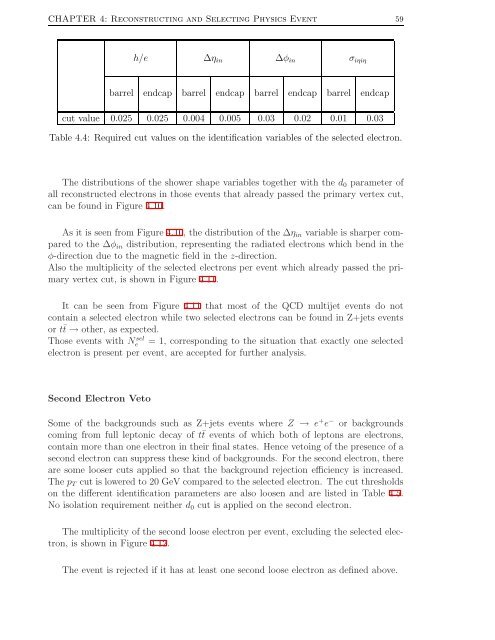Measurement of the Jet Energy Scale in the CMS experiment ... - IIHE
Measurement of the Jet Energy Scale in the CMS experiment ... - IIHE
Measurement of the Jet Energy Scale in the CMS experiment ... - IIHE
You also want an ePaper? Increase the reach of your titles
YUMPU automatically turns print PDFs into web optimized ePapers that Google loves.
CHAPTER 4: Reconstruct<strong>in</strong>g and Select<strong>in</strong>g Physics Event 59h/e ∆η <strong>in</strong> ∆φ <strong>in</strong> σ iηiηbarrel endcap barrel endcap barrel endcap barrel endcapcut value 0.025 0.025 0.004 0.005 0.03 0.02 0.01 0.03Table 4.4: Required cut values on <strong>the</strong> identification variables <strong>of</strong> <strong>the</strong> selected electron.The distributions <strong>of</strong> <strong>the</strong> shower shape variables toge<strong>the</strong>r with <strong>the</strong> d 0 parameter <strong>of</strong>all reconstructed electrons <strong>in</strong> those events that already passed <strong>the</strong> primary vertex cut,can be found <strong>in</strong> Figure 4.10.As it is seen from Figure 4.10, <strong>the</strong> distribution <strong>of</strong> <strong>the</strong> ∆η <strong>in</strong> variable is sharper comparedto <strong>the</strong> ∆φ <strong>in</strong> distribution, represent<strong>in</strong>g <strong>the</strong> radiated electrons which bend <strong>in</strong> <strong>the</strong>φ-direction due to <strong>the</strong> magnetic field <strong>in</strong> <strong>the</strong> z-direction.Also <strong>the</strong> multiplicity <strong>of</strong> <strong>the</strong> selected electrons per event which already passed <strong>the</strong> primaryvertex cut, is shown <strong>in</strong> Figure 4.11.It can be seen from Figure 4.11 that most <strong>of</strong> <strong>the</strong> QCD multijet events do notconta<strong>in</strong> a selected electron while two selected electrons can be found <strong>in</strong> Z+jets eventsor t¯t → o<strong>the</strong>r, as expected.Those events with Nesel = 1, correspond<strong>in</strong>g to <strong>the</strong> situation that exactly one selectedelectron is present per event, are accepted for fur<strong>the</strong>r analysis.Second Electron VetoSome <strong>of</strong> <strong>the</strong> backgrounds such as Z+jets events where Z → e + e − or backgroundscom<strong>in</strong>g from full leptonic decay <strong>of</strong> t¯t events <strong>of</strong> which both <strong>of</strong> leptons are electrons,conta<strong>in</strong> more than one electron <strong>in</strong> <strong>the</strong>ir f<strong>in</strong>al states. Hence veto<strong>in</strong>g <strong>of</strong> <strong>the</strong> presence <strong>of</strong> asecond electron can suppress <strong>the</strong>se k<strong>in</strong>d <strong>of</strong> backgrounds. For <strong>the</strong> second electron, <strong>the</strong>reare some looser cuts applied so that <strong>the</strong> background rejection efficiency is <strong>in</strong>creased.The p T cut is lowered to 20 GeV compared to <strong>the</strong> selected electron. The cut thresholdson <strong>the</strong> different identification parameters are also loosen and are listed <strong>in</strong> Table 4.5.No isolation requirement nei<strong>the</strong>r d 0 cut is applied on <strong>the</strong> second electron.The multiplicity <strong>of</strong> <strong>the</strong> second loose electron per event, exclud<strong>in</strong>g <strong>the</strong> selected electron,is shown <strong>in</strong> Figure 4.12.The event is rejected if it has at least one second loose electron as def<strong>in</strong>ed above.
















